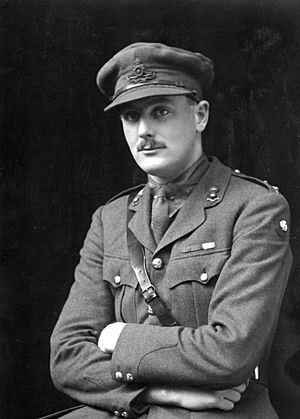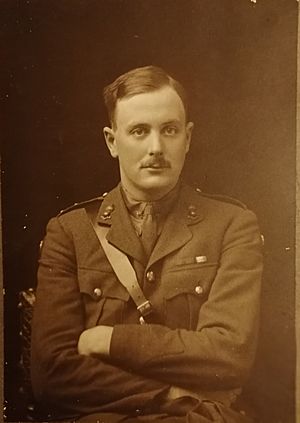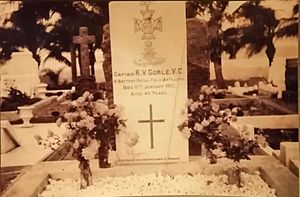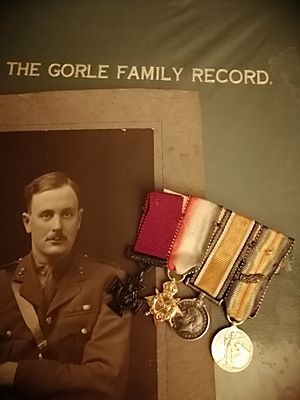Robert Vaughan Gorle facts for kids
Quick facts for kids
Robert Vaughan Gorle
|
|
|---|---|
 |
|
| Nickname(s) | Rob |
| Born | 6 May 1896 Southsea, Hampshire |
| Died | 9 January 1937 Durban, South Africa |
| Buried |
Stellawood Cemetery, Durban
|
| Allegiance | |
| Service/ |
|
| Rank | Temporary Lieutenant |
| Unit | Royal Artillery |
| Battles/wars | World War I |
| Awards |
|
| Other work | Farmer in Northern Rhodesia, Sergeant-at-Arms to the Southern Rhodesian Legislative Assembly, Parliamentary Librarian |
Robert Vaughan Gorle (6 May 1896 – 9 January 1937) was an English soldier. He received the Victoria Cross (VC). This is the highest award for bravery given to British and Commonwealth forces. It is given for amazing courage when facing the enemy.
Gorle was born in Southsea, England, on May 6, 1896. He went to Malvern College and Rugby School. Before World War I, he worked as a farmer in South Africa.
Contents
Robert Gorle's Bravery in World War I
Robert Gorle was a temporary lieutenant in the British Army. He was part of the Royal Field Artillery. His brave actions happened near Ledegem, Belgium, during the First World War. This is where he earned his Victoria Cross.
The Battle of Ledeghem
On October 1, 1918, Gorle's unit supported an attack. This was during the fourth and last battle of Ypres. The attack started with artillery fire. But other allied troops could not move forward. The British soldiers began to fall back.
Lieutenant Gorle saw this happening. He bravely moved his gun forward. He fired it three times directly at the enemy. This was a very dangerous thing to do.
A Moment of Courage
The 38th (Ulster) division saw Gorle's amazing bravery. They were inspired by his actions. They rallied and joined Gorle and his men. Together, they defeated the enemy machine gun nests. These nests were on a place called Hill 41.
Nine months later, on June 19, 1919, King George VI gave Gorle his medal. This happened at Buckingham Palace. It was a proud moment for his family. His father had also been very brave in the Boer Wars. He received a different medal, the Distinguished Service Order.
What His Award Citation Said
The official document about his award was published on December 14, 1918. It said he showed "most conspicuous bravery, initiative and devotion to duty." It explained how he brought his gun into action in very exposed places. He knocked out enemy machine guns by firing from 500 to 600 yards away.
The citation also said that when the infantry was pushed back, he galloped his gun forward. He knocked out more machine guns. His actions were a "magnificent example" to the soldiers. They then rallied and took back part of the village.
Life After the War
After the war, Gorle went back to Africa. He settled in Southern Rhodesia. There, he became the Sergeant-at-Arms for the Southern Rhodesian Legislative Assembly. This role is like an officer who keeps order in a parliament.
Robert Gorle died on January 9, 1937. He passed away from yellow fever. He was buried in Stellawood Cemetery in Durban, South Africa.
His Victoria Cross medal is now on display. You can see it at the Lord Ashcroft Gallery. This gallery is part of the Imperial War Museum in London.
Images for kids





